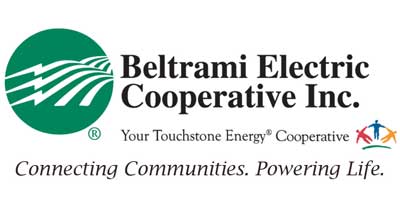If you lived in the area served by Beltrami Electric Cooperative 80 years ago, you would have experienced darkness so complete it might have frightened you. Except for the feeble orange glow from a lantern carried by a farmer tending his chores, there was no light.
It was a time of great hardship for the people living outside the city limits. Their day began and ended with the rise and set of the sun. There was no indoor plumbing. Water had to be carried from a creek, lake or a shallow well. When nature called, one headed to the outhouse; where a daily battle was waged with wasps, spiders and snakes.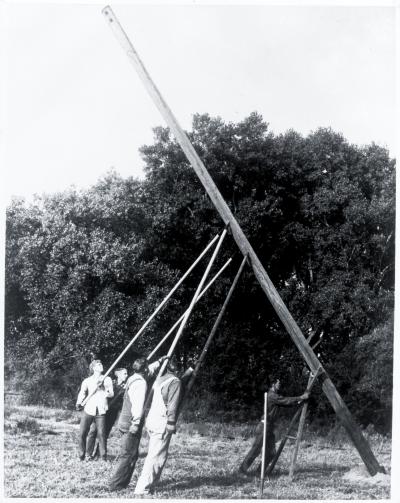
Imagine cooking on a wood stove today. Many housewives cooked with a lantern in one hand and a spoon in the other. What about laundry? Laundry day meant hauling more water, heating it in an iron kettle and then boiling the clothes in hopes of removing the grime. Clothes were then scrubbed on a corrugated washboard, taking care to not scrub the knuckles as well. The clean clothes were then hung on a clothesline, outside in the summer, and wherever space could be found inside during the winter. Imagine having to break the ice off your sheets before putting them back on the bed!
How many of you can remember the day the lights came on? I’m not talking about when you got power restored after the last severe storm. The day the lights came on in the rural areas of Minnesota was a great moment in our history.
By all accounts June 20, 1940, was the birth date of Beltrami Electric Cooperative, when a small group of people met at the Beltrami County Courthouse to sign incorporation papers. These first articles of incorporation read “We, the undersigned persons of full age, acting for ourselves as individuals, for the purpose of forming a cooperative association…” that is what a cooperative is all about. So simply and accurately stated that individuals formed together to help themselves provide what they could not do individually. Today, more than 80 years later we celebrate the success of that action.
It is only appropriate to acknowledge the foresight and determination of our original founding board members:
-
John Wolden, Saum
-
Charles Moller, Pinewood
-
Peter J. Welter, Puposky
-
Emil Gustafson, Puposky
-
Lilly Bakkum, Bemidji
-
Emil E. Schulke, Tenstrike
-
Alma Gerlinger, Bemidji
-
Ben Goranson, Kelliher
-
John A. Engberg, Blackduck
These nine people, along with help from the local county agricultural agent, Milton B. Taylor held meetings and after a vote it was determined that a rural electric cooperative should be formed. This meeting was on June 20, 1940. M.B. Taylor would become the first general manager of Beltrami Electric Cooperative, serving from 1941-1947. Earl H. Larson replaced M.B Taylor in 1947 and served as general manager until he retired in 1982.
These early incorporators went door to door to sell $5 memberships to every rural family, in Beltrami County, that wanted electricity. Their efforts were successful and resulted in an early membership total of 321.
They worked to obtain loans from the federal government, through REA to get started. Today, Beltrami Electric Cooperative, Inc. is their legacy. What would they think today to see the project they worked so hard to get started grow to more than 18,100 members? We have no doubt they would be proud of this cooperative’s history..jpg)
Beltrami Electric has been blessed with growth through most of its history. However, the early years were tough as agriculture was hit hard and net out-migration from 1950-1960 reached 20%. Leaders did what was needed to survive those times. Following the 1960’s, steady growth helped the cooperative expand and improve its distribution plant. The cooperative experienced load growth at about 2% per year throughout the 1990’s and up through 2006.
In the late 60’s and 70’s, underground distribution became popular. The first underground cable available was not of high quality and pre-maturely had to be replaced. Today our system consists of over 70% underground. Underground (or the absence of overhead) is pleasing to the eye, and most would say to the environment too. But it does come with a cost; including both a higher cost to install and a higher cost to repair, compared to overhead lines.
Office manager Don Anderson became the third general manager of the cooperative when he accepted the position in 1982. He retired in 1989, after a lifelong career working for rural electric cooperatives.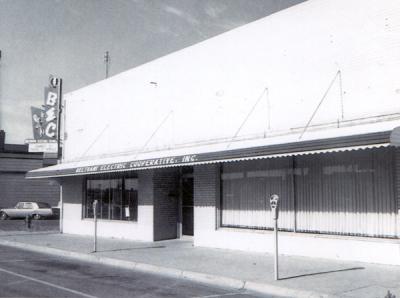
We have seen many significant accomplishments over the past 80 years. A significant program that started in 1977 was the load management program. Back then it was called “Ripple” and to this day the name still sticks for some of our members. This program has saved our members millions of dollars since its inception. Minnkota’s load management program was one of the first in the country and continues to be one of the most successful.
In 1992, under general manager Roger Spiry, Beltrami Electric Cooperative combined efforts with two other rural electric cooperatives, two rural telephone cooperatives and two rural telephone companies to form Rural Vision, LLC. Rural Vision provided Direct Broadcast Satellite Television service to the rural areas of Beltrami, Hubbard, Cass, Crow Wing and Morrison counties. The office was located inside of the Paul Bunyan Telephone Cooperative headquarters with a targeted broadcasting date of April 1994, to bring more than 100 television channels to its subscribers.
In 1996, Cooperative Development, LLC was formed, a partnership between Beltrami Electric and Paul Bunyan Telephone, along with the purchase and creation of Bemidji’s Technology Park. A research and development park, it was designed to provide technology-oriented companies an opportunity to do business in a progressive, business-friendly environment, giving them access to advanced communications and services.
Major changes in technology lead to the testing of a new meter reading device in 1997, called the “Turtle”. Manufactured by Hunt Technologies in Pequot Lakes, Minn., this device sent meter readings back to the substations over the power lines. This reduced the time that line crews had to spend driving around to read meters when the cooperative didn’t receive readings from members.
In 1998, Pegasus purchased Rural Vision, LLC., the locally owned franchise that provided DIRECTV to north-central Minnesota. The Beltrami Electric Cooperative board of directors elected to use proceeds from the sale to offset future rate increases, resulting in rate stability for many years.
Beltrami Electric partnered with six other cooperatives to form Northern Safety & Security in 1999, providing various home monitoring security systems, such as “Life-Call”, which allowed subscribers to call for help with the push of the button.
 Wal-Mart approached Beltrami Electric in 1999, wanting to purchase the property at 2025 Paul Bunyan Drive NW. As a result, Beltrami Electric decided to build on a new site located within Technology Park, which the cooperative already jointly owned with Paul Bunyan Telephone. In March 2000, a groundbreaking ceremony was held, and Beltrami Electric employees moved into the new 62,000-square-foot headquarters in December. Beltrami Electric started to lease space on the second floor of the headquarters a couple of years later, and today includes Sanford Health Foundation, Sanford Health Training Facility, Army Corps of Engineers, and the Idea Circle.
Wal-Mart approached Beltrami Electric in 1999, wanting to purchase the property at 2025 Paul Bunyan Drive NW. As a result, Beltrami Electric decided to build on a new site located within Technology Park, which the cooperative already jointly owned with Paul Bunyan Telephone. In March 2000, a groundbreaking ceremony was held, and Beltrami Electric employees moved into the new 62,000-square-foot headquarters in December. Beltrami Electric started to lease space on the second floor of the headquarters a couple of years later, and today includes Sanford Health Foundation, Sanford Health Training Facility, Army Corps of Engineers, and the Idea Circle.
In January 2002, Minnkota Power Cooperative completed North Dakota’s first commercial-scale utility-owned wind turbine near Valley City, N.D. Later that year, in July, an identical 900-kW wind turbine was completed near Petersburg, N.D., allowing cooperatives in the Minnkota system to offer wind-generated electricity to members for an additional charge.
In 2007, Beltrami Electric felt the impact of the Great Recession, deemed the worst global recession since World War II, with economic downturn resulting in a decrease in new electric services of more than 30 percent.
Minnkota Power Cooperative purchased 357 of wind energy from NextEra Energy Resources, boosting Minnkota’s total renewable resources to 30 percent of its total generation. With the addition of the Langdon and Ashtabula Wind Energy Centers, Minnkota is recognized by the U.S. Department of Energy as the Wind Energy Cooperative of the year.
2009 saw wholesale power rates increase significantly as Minnkota faced major events. The Environmental Protection Agency (EPA) required Minnkota to invest more than $400 million in environmental upgrades. As the same time, electricity markets prices fall and Minnkota is forced to sell excess wind energy into a low market at a loss, resulting in a $20 million revenue shortfall due to the economic downturn. Beltrami Electric’s new services dropped by one-third, and as a result of a weak economy, the Ainsworth lumber mill south of Bemidji closes. This impacted not only their employees, but also decreased Beltrami Electric’s annual kWh sales by 8.5 percent.
Ensuring financing for the cooperative’s $132 million in current assets at attractive interest rates was key to keeping rates affordable. Rural Electrification would not have happened without REA loans. In 1940, an application for a loan of $250,000 was approved, allowing Beltrami Electric Cooperative to start the process of receiving bids for the construction of the first lines to deliver electricity to the rural areas. However, by 1969 REA could no longer provide significant funding, so as a result cooperatives joined together to form the Cooperative Finance Corporation (CFC), to provide supplemental financing. In 1997, it became advantageous for Beltrami Electric to buy out our loans from the REA loan program. However, in 2010 we again returned to the Rural Utilities Service (RUS, formerly REA) when we could receive the lowest rate loan in our history.
In 2014, Minnkota made another significant investment of $353 million to improve system reliability, with the completion of a 250-mile high voltage transmission line from Center to Grand Forks, ND.
 Beltrami Electric’s community solar garden project, Northern Solar, an 80kW direct current (DC) solar garden is proposed to members, offering interested members an option to lease the energy output of panels over a 20-year period. Construction began in 2016, and a groundbreaking ceremony was held on August 2017, with members subscribing to just over half of the 180-panels.
Beltrami Electric’s community solar garden project, Northern Solar, an 80kW direct current (DC) solar garden is proposed to members, offering interested members an option to lease the energy output of panels over a 20-year period. Construction began in 2016, and a groundbreaking ceremony was held on August 2017, with members subscribing to just over half of the 180-panels.
A systemwide meter upgrade began in November 2016, as the metering system installed in the mid-1990s reached its end-life. Beltrami Electric began the three-year conversion/installation project for a new Tantalus metering system, which offers two-way communication and features such as remote connect/disconnect, voltage readings, demand readings, blink counts, etc. These new meters are designed to improve reliability and give members more tools and opportunities to manage and save energy.
As the market for electric vehicles began to grow, Beltrami Electric employs efforts to reduce range anxiety and encourage the adoption of EVs in the region. Partnering with the city of Blackduck and the Big Bog State Recreation Area to install two public Level 2 EV chargers. A third charging station, which includes both a Level 2 and a Direct Current (DC) fast charger, are installed at cooperative headquarters, near the community solar garden.
One of the things we have always done well as cooperatives is work together with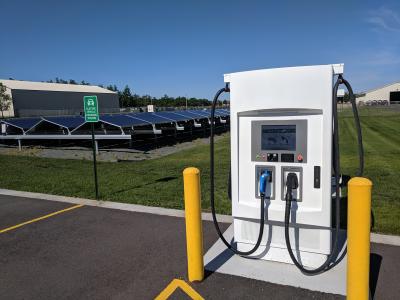 other cooperatives. National Rural Electric Cooperative Association (NRECA) and Minnesota Rural Electric Association (MREA) provide legislative, safety and educational services. We have a long list of acronyms for cooperative organizations that provide us with software solutions, financing, and other services and products that we can’t economically obtain on our own.
other cooperatives. National Rural Electric Cooperative Association (NRECA) and Minnesota Rural Electric Association (MREA) provide legislative, safety and educational services. We have a long list of acronyms for cooperative organizations that provide us with software solutions, financing, and other services and products that we can’t economically obtain on our own.
Through our membership in Minnkota Power Cooperative, along with 10 other distribution cooperatives in northwestern Minnesota and eastern North Dakota, we have ownership in Minnkota’s generation and transmission facilities to reliably meet our energy needs. A major investment in renewable energy has been made by Minnkota since 2007, and today our generation portfolio includes a diverse mix of coal, wind and hydro resources. In terms of nameplate capacity, about 55 percent is derived from coal, 34 percent from wind, 8 percent from hydro and 3 percent from other resources.
Today, Beltrami Electric Cooperative serves over 18,100 members in a 3,000 square-mile area including Beltrami, Cass, Clearwater, Hubbard, Itasca, and Koochiching counties.
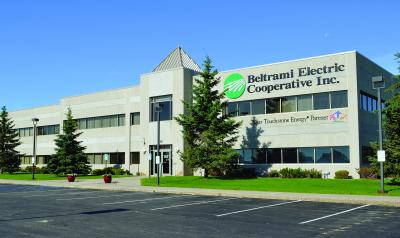 Beltrami Electric is a not-for-profit electric cooperative built by the communities we serve to deliver reliable, sustainable and affordable energy. And, because we answer to local members like you, rather than out-of-town shareholders, our electric cooperative has a unique understanding of our local needs. The opportunity to provide an important service, while embracing traditional community values, has never been greater. It’s a passion we share with you, our members, for making our community a place we’re all proud to call home. Your Membership matters because you matter to your Cooperative.
Beltrami Electric is a not-for-profit electric cooperative built by the communities we serve to deliver reliable, sustainable and affordable energy. And, because we answer to local members like you, rather than out-of-town shareholders, our electric cooperative has a unique understanding of our local needs. The opportunity to provide an important service, while embracing traditional community values, has never been greater. It’s a passion we share with you, our members, for making our community a place we’re all proud to call home. Your Membership matters because you matter to your Cooperative.
